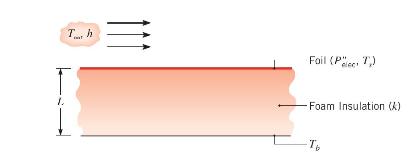Consider the solar collector of Problem 3.89. After reaching a steady-state operating condition with (q_{text {rad }}^{prime
Question:
Consider the solar collector of Problem 3.89. After reaching a steady-state operating condition with \(q_{\text {rad }}^{\prime \prime}=800 \mathrm{~W} / \mathrm{m}^{2}\), the net radiation flux to the surface is suddenly reduced to \(q_{\mathrm{rad}}^{\prime \prime}=0\) due to the passage of a cloud.
(a) With \(q_{\text {rad }}^{\prime \prime}=800 \mathrm{~W} / \mathrm{m}^{2}\), determine the steady-state temperature distribution within the absorber plate and the rate of thermal energy delivered to a single tube per unit length, \(q^{\prime}\), using a finite difference model with \(\Delta x=10 \mathrm{~mm}\). Take advantage of the symmetry about \(x=0\) (located directly above a representative tube) and \(L / 2\) to minimize the number of finite-difference equations. What is the maximum steady-state absorber plate temperature? Evaluate the plate properties at \(T=325 \mathrm{~K}\).
(b) Using the temperature distribution of part
(a) as the initial condition, determine the temperature distribution within the absorber plate \(T(x, t)\) when \(q_{\text {rad }}^{\prime \prime}=0\) over the time period \(0 \leq t \leq 500 \mathrm{~s}\). Use a grid spacing of \(\Delta x=10 \mathrm{~mm}\) and a time step of \(\Delta t=1 \mathrm{~s}\). Plot the maximum absorber plate temperature over the time period \(0 \leq t \leq 500 \mathrm{~s}\). What is the maximum absorber plate temperature at \(t=0,10\), and \(100 \mathrm{~s}\) ? Hint: The solution will be expedited by using the \(\operatorname{Der}(T, t)\) function of \(I H T\). See Problem 5.94.
(c) Plot the heat transfer rate to the tube per unit length over the time period \(0 \leq t \leq 500 \mathrm{~s}\). How long can the cloud cover last before the rate of heat transfer to the tube from the absorber plate is reduced by 50 percent?
Data From Problem 3.8:-
A technique for measuring convection heat transfer coefficients involves bonding one surface of a thin metallic foil to an insulating material and exposing the other surface to the fluid flow conditions of interest.
By passing an electric current through the foil, heat is dissipated uniformly within the foil and the corresponding flux, \(P_{\text {elec }}^{\prime \prime}\), may be inferred from related voltage and current measurements. If the insulation thickness \(L\) and thermal conductivity \(k\) are known and the fluid, foil, and insulation temperatures \(\left(T_{\infty}, T_{s}, T_{b}\right)\) are measured, the convection coefficient may be determined. Consider conditions for which \(T_{\infty}=T_{b}=25^{\circ} \mathrm{C}, P_{\text {elec }}^{\prime \prime}=2000 \mathrm{~W} / \mathrm{m}^{2}\), \(L=10 \mathrm{~mm}\), and \(k=0.040 \mathrm{~W} / \mathrm{m} \cdot \mathrm{K}\).
(a) With water flow over the surface, the foil temperature measurement yields \(T_{s}=27^{\circ} \mathrm{C}\). Determine the convection coefficient. What error would be incurred by assuming all of the dissipated power to be transferred to the water by convection?
(b) If, instead, air flows over the surface and the temperature measurement yields \(T_{s}=125^{\circ} \mathrm{C}\), what is the convection coefficient? The foil has an emissivity of 0.15 and is exposed to large surroundings at \(25^{\circ} \mathrm{C}\). What error would be incurred by assuming all of the dissipated power to be transferred to the air by convection?
(c) Typically, heat flux gages are operated at a fixed temperature \(\left(T_{s}\right)\), in which case the power dissipation provides a direct measure of the convection coefficient. For \(T_{s}=27^{\circ} \mathrm{C}\), plot \(P_{\text {elec }}^{\prime \prime}\) as a function of \(h_{o}\) for \(10 \leq h_{o} \leq 1000 \mathrm{~W} / \mathrm{m}^{2} \cdot \mathrm{K}\). What effect does \(h_{o}\) have on the error associated with neglecting conduction through the insulation?
Step by Step Answer:

Fundamentals Of Heat And Mass Transfer
ISBN: 9781119220442
8th Edition
Authors: Theodore L. Bergman, Adrienne S. Lavine




